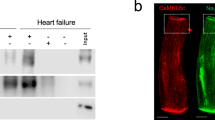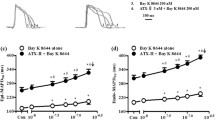Abstract
Increased late sodium current (late INa) is an important arrhythmogenic trigger in cardiac disease. It prolongs cardiac action potential and leads to an increased SR Ca2+ leak. This study investigates the contribution of Ca2+/Calmodulin-dependent kinase II (CaMKII), protein kinase A (PKA) and conversely acting protein phosphatases 1 and 2A (PP1, PP2A) to this subcellular crosstalk. Augmentation of late INa (ATX-II) in murine cardiomyocytes led to an increase of diastolic Ca2+ spark frequency and amplitudes of Ca2+ transients but did not affect SR Ca2+ load. Interestingly, inhibition of both, CaMKII and PKA, attenuated the late INa-dependent induction of the SR Ca2+ leak. PKA inhibition additionally reduced the amplitudes of systolic Ca2+ transients. FRET-measurements revealed increased levels of cAMP upon late INa augmentation, which could be prevented by simultaneous inhibition of Na+/Ca2+-exchanger (NCX) suggesting that PKA is activated by Ca2+-dependent cAMP-production. Whereas inhibition of PP2A showed no effect on late INa-dependent alterations of Ca2+ cycling, additional inhibition of PP1 further increased the SR Ca2+ leak. In line with this, selective activation of PP1 yielded a strong reduction of the late INa-induced SR Ca2+ leak and did not affect systolic Ca2+ release. This study indicates that phosphatase/kinase-balance is perturbed upon increased Na+ influx leading to disruption of ventricular Ca2+ cycling via CaMKII- and PKA-dependent pathways. Importantly, an activation of PP1 at RyR2 may represent a promising new toehold to counteract pathologically increased kinase activity.







Similar content being viewed by others
References
Amran MS, Homma N, Hashimoto K (2003) Pharmacology of KB-R7943: a Na+ -Ca2+ exchange inhibitor. Cardiovasc Drug Rev 21:255–276
Antzelevitch C, Nesterenko V, Shryock JC, Rajamani S, Song Y, Belardinelli L (2014) The role of late I Na in development of cardiac arrhythmias. Handb Exp Pharmacol 221:137–168. https://doi.org/10.1007/978-3-642-41588-3_7
Beckendorf J, van den Hoogenhof MMG, Backs J (2018) Physiological and unappreciated roles of CaMKII in the heart. Basic Res Cardiol 113:29. https://doi.org/10.1007/s00395-018-0688-8
Belardinelli L, Giles WR, Rajamani S, Karagueuzian HS, Shryock JC (2015) Cardiac late Na(+) current: proarrhythmic effects, roles in long QT syndromes, and pathological relationship to CaMKII and oxidative stress. Heart Rhythm 12:440–448. https://doi.org/10.1016/j.hrthm.2014.11.009
Belardinelli L, Shryock JC, Fraser H (2006) Inhibition of the late sodium current as a potential cardioprotective principle: effects of the late sodium current inhibitor ranolazine. Heart 92(Suppl 4):iv6–iv14. https://doi.org/10.1136/hrt.2005.078790
Belevych AE, Ho H-T, Bonilla IM, Terentyeva R, Schober KE, Terentyev D, Carnes CA, Györke S (2017) The role of spatial organization of Ca2+ release sites in the generation of arrhythmogenic diastolic Ca2+ release in myocytes from failing hearts. Basic Res Cardiol 112:44. https://doi.org/10.1007/s00395-017-0633-2
Borner S, Schwede F, Schlipp A, Berisha F, Calebiro D, Lohse MJ, Nikolaev VO (2011) FRET measurements of intracellular cAMP concentrations and cAMP analog permeability in intact cells. Nat Protoc 6:427–438. https://doi.org/10.1038/nprot.2010.198
Calebiro D, Nikolaev VO, Gagliani MC, de Filippis T, Dees C, Tacchetti C, Persani L, Lohse MJ (2009) Persistent cAMP-signals triggered by internalized G-protein-coupled receptors. PLoS Biol 7:e1000172. https://doi.org/10.1371/journal.pbio.1000172
Chatterjee J, Beullens M, Sukackaite R, Qian J, Lesage B, Hart DJ, Bollen M, Kohn M (2012) Development of a peptide that selectively activates protein phosphatase-1 in living cells. Angew Chem Int Ed Engl 51:10054–10059. https://doi.org/10.1002/anie.201204308
Chatterjee J, Köhn M (2013) Targeting the untargetable: recent advances in the selective chemical modulation of protein phosphatase-1 activity. Curr Opin Chem Biol 17:361–368. https://doi.org/10.1016/j.cbpa.2013.04.008
Cohen P (1989) The structure and regulation of protein phosphatases. Annu Rev Biochem 58:453–508. https://doi.org/10.1146/annurev.bi.58.070189.002321
Edelstein A, Amodaj N, Hoover K, Vale R, Stuurman N (2010) Computer control of microscopes using microManager. Curr Protoc Mol Biol Chapter 14(Unit14):20. https://doi.org/10.1002/0471142727.mb1420s92
Eleftheriadou O, Boguslavskyi A, Longman MR, Cowan J, Francois A, Heads RJ, Wadzinski BE, Ryan A, Shattock MJ, Snabaitis AK (2017) Expression and regulation of type 2A protein phosphatases and alpha4 signalling in cardiac health and hypertrophy. Basic Res Cardiol 112:37. https://doi.org/10.1007/s00395-017-0625-2
Fahs S, Lujan P, Kohn M (2016) Approaches to study phosphatases. ACS Chem Biol 11:2944–2961. https://doi.org/10.1021/acschembio.6b00570
Fischer TH, Eiringhaus J, Dybkova N, Forster A, Herting J, Kleinwachter A, Ljubojevic S, Schmitto JD, Streckfuss-Bomeke K, Renner A, Gummert J, Hasenfuss G, Maier LS, Sossalla S (2014) Ca(2+)/calmodulin-dependent protein kinase II equally induces sarcoplasmic reticulum Ca(2+) leak in human ischaemic and dilated cardiomyopathy. Eur J Heart Fail 16:1292–1300. https://doi.org/10.1002/ejhf.163
Fischer TH, Eiringhaus J, Dybkova N, Saadatmand A, Pabel S, Weber S, Wang Y, Kohn M, Tirilomis T, Ljubojevic S, Renner A, Gummert J, Maier LS, Hasenfuss G, El-Armouche A, Sossalla S (2018) Activation of protein phosphatase 1 by a selective phosphatase disrupting peptide reduces sarcoplasmic reticulum Ca(2+) leak in human heart failure. J Heart Fail, Eur. https://doi.org/10.1002/ejhf.1297
Fischer TH, Herting J, Mason FE, Hartmann N, Watanabe S, Nikolaev VO, Sprenger JU, Fan P, Yao L, Popov AF, Danner BC, Schondube F, Belardinelli L, Hasenfuss G, Maier LS, Sossalla S (2015) Late INa increases diastolic SR-Ca2+ -leak in atrial myocardium by activating PKA and CaMKII. Cardiovasc Res 107:184–196. https://doi.org/10.1093/cvr/cvv153
Fischer TH, Herting J, Tirilomis T, Renner A, Neef S, Toischer K, Ellenberger D, Forster A, Schmitto JD, Gummert J, Schondube FA, Hasenfuss G, Maier LS, Sossalla S (2013) Ca2+/calmodulin-dependent protein kinase II and protein kinase A differentially regulate sarcoplasmic reticulum Ca2+ leak in human cardiac pathology. Circulation 128:970–981. https://doi.org/10.1161/CIRCULATIONAHA.113.001746
Fish KM, Ladage D, Kawase Y, Karakikes I, Jeong D, Ly H, Ishikawa K, Hadri L, Tilemann L, Muller-Ehmsen J, Samulski RJ, Kranias EG, Hajjar RJ (2013) AAV9.I-1c delivered via direct coronary infusion in a porcine model of heart failure improves contractility and mitigates adverse remodeling. Circ Heart Fail 6:310–317. https://doi.org/10.1161/circheartfailure.112.971325
Hell JW (2014) CaMKII: claiming center stage in postsynaptic function and organization. Neuron 81:249–265. https://doi.org/10.1016/j.neuron.2013.12.024
Isenberg G, Ravens U (1984) The effects of the Anemonia sulcata toxin (ATX II) on membrane currents of isolated mammalian myocytes. J Physiol 357:127–149. https://doi.org/10.1113/jphysiol.1984.sp015493
Ju YK, Saint DA, Gage PW (1996) Hypoxia increases persistent sodium current in rat ventricular myocytes. J Physiol 497(Pt 2):337–347. https://doi.org/10.1113/jphysiol.1996.sp021772
Landstrom AP, Dobrev D, Wehrens XHT (2017) Calcium signaling and cardiac arrhythmias. Circ Res 120:1969–1993. https://doi.org/10.1161/CIRCRESAHA.117.310083
Maier LS, Sossalla S (2013) The late Na current as a therapeutic target: where are we? J Mol Cell Cardiol 61:44–50. https://doi.org/10.1016/j.yjmcc.2013.03.001
Maltsev VA, Sabbah HN, Higgins RS, Silverman N, Lesch M, Undrovinas AI (1998) Novel, ultraslow inactivating sodium current in human ventricular cardiomyocytes. Circulation 98:2545–2552. https://doi.org/10.1161/01.CIR.98.23.2545
Maltsev VA, Undrovinas A (2008) Late sodium current in failing heart: friend or foe? Prog Biophys Mol Biol 96:421–451. https://doi.org/10.1016/j.pbiomolbio.2007.07.010
Marks AR (2013) Calcium cycling proteins and heart failure: mechanisms and therapeutics. J Clin Invest 123:46–52. https://doi.org/10.1172/JCI62834
Meyer-Roxlau S, Lämmle S, Opitz A, Künzel S, Joos JP, Neef S, Sekeres K, Sossalla S, Schöndube F, Alexiou K, Maier LS, Dobrev D, Guan K, Weber S, El-Armouche A (2017) Differential regulation of protein phosphatase 1 (PP1) isoforms in human heart failure and atrial fibrillation. Basic Res Cardiol 112:43. https://doi.org/10.1007/s00395-017-0635-0
Picht E, Zima AV, Blatter LA, Bers DM (2007) SparkMaster: automated calcium spark analysis with ImageJ. Am J Physiol Cell Physiol 293:C1073–C1081. https://doi.org/10.1152/ajpcell.00586.2006
Rivolta I, Abriel H, Tateyama M, Liu H, Memmi M, Vardas P, Napolitano C, Priori SG, Kass RS (2001) Inherited Brugada and long QT-3 syndrome mutations of a single residue of the cardiac sodium channel confer distinct channel and clinical phenotypes. J Biol Chem 276:30623–30630. https://doi.org/10.1074/jbc.M104471200
Ronchi C, Torre E, Rizzetto R, Bernardi J, Rocchetti M, Zaza A (2017) Late sodium current and intracellular ionic homeostasis in acute ischemia. Basic Res Cardiol 112:12. https://doi.org/10.1007/s00395-017-0602-9
Sag CM, Mallwitz A, Wagner S, Hartmann N, Schotola H, Fischer TH, Ungeheuer N, Herting J, Shah AM, Maier LS, Sossalla S, Unsold B (2014) Enhanced late I Na induces proarrhythmogenic SR Ca leak in a CaMKII-dependent manner. J Mol Cell Cardiol 76:94–105. https://doi.org/10.1016/j.yjmcc.2014.08.016
Shryock JC, Song Y, Rajamani S, Antzelevitch C, Belardinelli L (2013) The arrhythmogenic consequences of increasing late I Na in the cardiomyocyte. Cardiovasc Res 99:600–611. https://doi.org/10.1093/cvr/cvt145
Sossalla S, Kallmeyer B, Wagner S, Mazur M, Maurer U, Toischer K, Schmitto JD, Seipelt R, Schondube FA, Hasenfuss G, Belardinelli L, Maier LS (2010) Altered Na(+) currents in atrial fibrillation effects of ranolazine on arrhythmias and contractility in human atrial myocardium. J Am Coll Cardiol 55:2330–2342. https://doi.org/10.1016/j.jacc.2009.12.055
Sossalla S, Wagner S, Rasenack EC, Ruff H, Weber SL, Schondube FA, Tirilomis T, Tenderich G, Hasenfuss G, Belardinelli L, Maier LS (2008) Ranolazine improves diastolic dysfunction in isolated myocardium from failing human hearts—role of late sodium current and intracellular ion accumulation. J Mol Cell Cardiol 45:32–43. https://doi.org/10.1016/j.yjmcc.2008.03.006
Sprenger JU, Perera RK, Gotz KR, Nikolaev VO (2012) FRET microscopy for real-time monitoring of signaling events in live cells using unimolecular biosensors. J Vis Exp 25:e4081. https://doi.org/10.3791/4081
Toischer K, Hartmann N, Wagner S, Fischer TH, Herting J, Danner BC, Sag CM, Hund TJ, Mohler PJ, Belardinelli L, Hasenfuss G, Maier LS, Sossalla S (2013) Role of late sodium current as a potential arrhythmogenic mechanism in the progression of pressure-induced heart disease. J Mol Cell Cardiol 61:111–122. https://doi.org/10.1016/j.yjmcc.2013.03.021
Ward CA, Bazzazi H, Clark RB, Nygren A, Giles WR (2006) Actions of emigrated neutrophils on Na(+) and K(+) currents in rat ventricular myocytes. Prog Biophys Mol Biol 90:249–269. https://doi.org/10.1016/j.pbiomolbio.2005.07.003
Ward CA, Giles WR (1997) Ionic mechanism of the effects of hydrogen peroxide in rat ventricular myocytes. J Physiol 500(Pt 3):631–642
Watanabe S, Ishikawa K, Fish K, Oh JG, Motloch LJ, Kohlbrenner E, Lee P, Xie C, Lee A, Liang L, Kho C, Leonardson L, McIntyre M, Wilson S, Samulski RJ, Kranias EG, Weber T, Akar FG, Hajjar RJ (2017) Protein phosphatase inhibitor-1 gene therapy in a swine model of nonischemic heart failure. J Am Coll Cardiol 70:1744–1756. https://doi.org/10.1016/j.jacc.2017.08.013
World Medical Association (2013) World Medical Association Declaration of Helsinki: ethical principles for medical research involving human subjects. JAMA 310:2191–2194. https://doi.org/10.1001/jama.2013.281053
Acknowledgements
We gratefully acknowledge the technical assistance of K.-C. Hansing and T. Schulte. THF is funded by the Deutsche Forschungsgemeinschaft (DFG) through the SFB 1002 (A11). SS is supported by the Marga und Walter Boll-Stiftung through a research grant. MK is funded by the European Research Council (ERC) through a starting Grant (# 336567).
Author information
Authors and Affiliations
Corresponding author
Ethics declarations
Conflict of interest
The authors declare that they have no conflict of interest.
Rights and permissions
About this article
Cite this article
Eiringhaus, J., Herting, J., Schatter, F. et al. Protein kinase/phosphatase balance mediates the effects of increased late sodium current on ventricular calcium cycling. Basic Res Cardiol 114, 13 (2019). https://doi.org/10.1007/s00395-019-0720-7
Received:
Accepted:
Published:
DOI: https://doi.org/10.1007/s00395-019-0720-7




